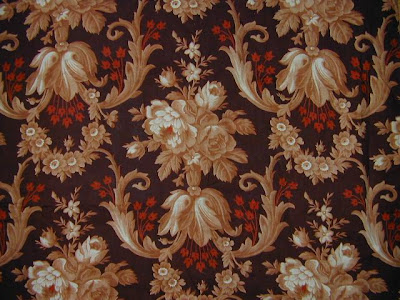 Everyone knows Paris - the great city of art, beauty and culture. But outside of Paris, France is largely rural and agricultural. Driving along smaller departmental roads, I was amazed at the carefully-tended orchards, the acres and acres of hand-pruned vineyards and the many vegetable gardens in and around the villages.
Everyone knows Paris - the great city of art, beauty and culture. But outside of Paris, France is largely rural and agricultural. Driving along smaller departmental roads, I was amazed at the carefully-tended orchards, the acres and acres of hand-pruned vineyards and the many vegetable gardens in and around the villages.The French revel in nature. They love a lazy afternoon in the country or a hike in the woods and always prefer to eat locally-grown produce. During the 19th century, French people were even more entranced with nature and its mysteries. In this post, we'll examine the verdure textile designs - those illustrated with verdent woods, a forest glen or other foliage - designed to bring the outdoors in.
Although this kind of woods and vista motif was a repeating theme, the color schemes were quite varied and often unusual.
Below are several examples of 19th century woodland scenics.
The first, with a off-white background and a foreground motif in olive, khaki, rose and mauve, the vista revealed is of a bubbling waterfall.
The next piece has a brown and tan forest glen with exotic flowers as the central motif that is printed on a greenish-gray background. This piece encompasses the traditional forest theme, but is quite unusual in the use of the oriental-style trees and bushes.
Verdure prints were also made that depicted woods or semi-jungle motifs, but did not incorporate a scene or vista. Three such printed fabrics are shown below. The first is a crowded motif that is thick with trees, bushes and many smaller plants, all done in muted blues and rusty browns. The plants are all fantasy plants and are not botanically identifiable.
The second swatch has a sparser design that is created by using tall spindly trees and rangy bushes. The main color is teal, which was a favorite in many leaf and verdure prints in the second half of the 19th century.
The last one in this post is the most unusual and is a favorite of mine. The designer chose a single large tree as the central motif, which is reminiscent of the Indian tree-of-life patterns. The tree depicted is an oak tree with acorns and is done in the softest olive and tan shades with accents of very muted mauve. The oak tree was the most common tree in France and is a symbol of strength. Fluttering around the powerful tree are lively songbirds. Magnifique!

































